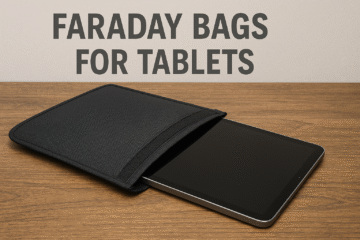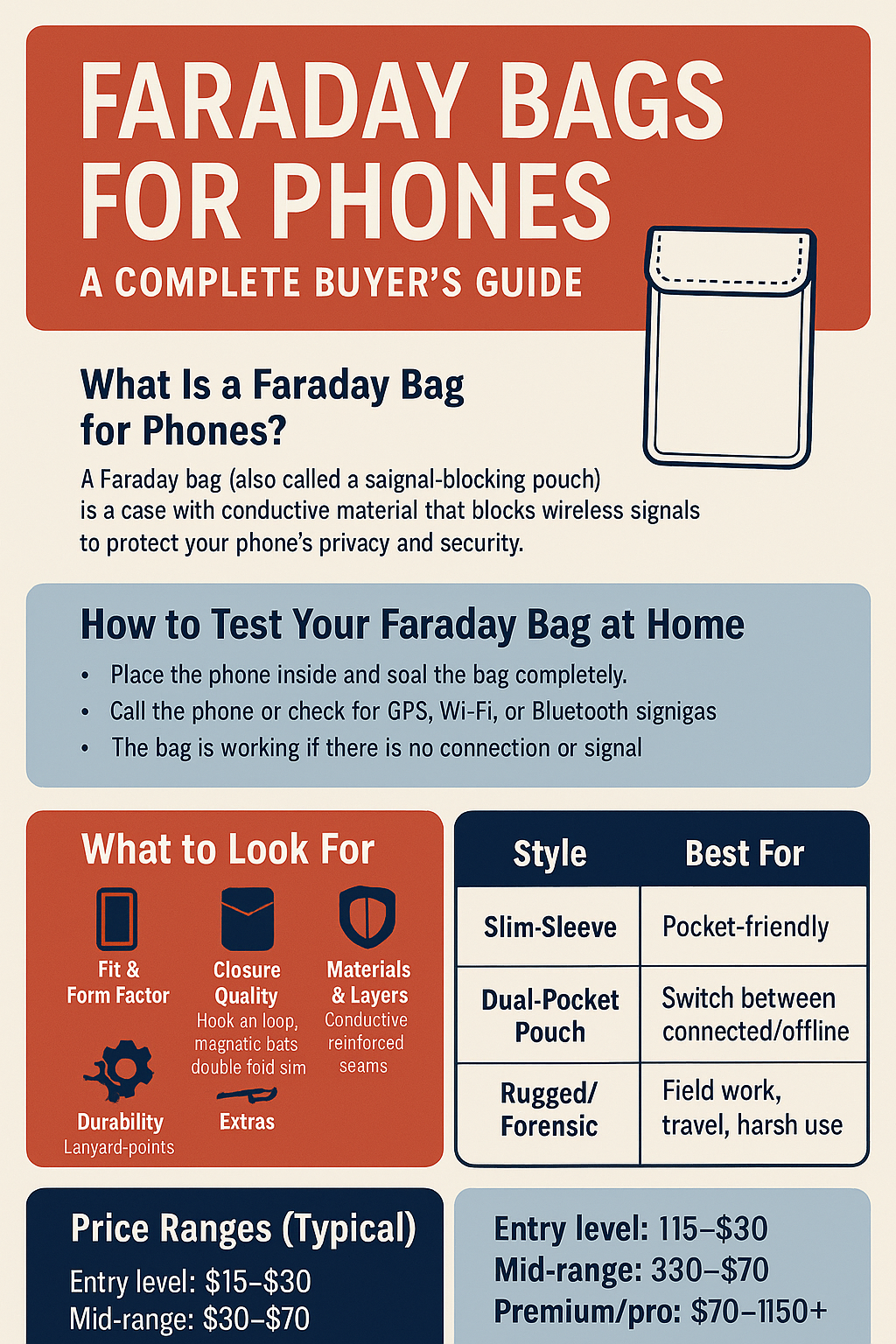Faraday Bags for Laptops: Complete Guide to Digital Privacy, Security, and EMF Protection
Introduction
Modern laptops are powerhouses of productivity—but they’re also constant beacons of wireless communication. Between Wi-Fi, Bluetooth, NFC, and cellular connectivity (for some models), your laptop continuously emits and receives electromagnetic signals that can be intercepted, tracked, or used for unauthorized data collection.
Faraday Bags for Laptops are designed to eliminate that risk. By blocking all incoming and outgoing wireless signals, these specialized enclosures ensure your device stays completely invisible to networks and scanners. Whether you’re protecting trade secrets, preventing cyber intrusion, or simply reducing EMF exposure, a Faraday laptop bag provides the ultimate barrier against today’s invisible digital threats.
What Are Faraday Bags for Laptops?
A Faraday Bag for Laptops is a protective case lined with conductive materials that form a complete electromagnetic shield—often referred to as a “portable Faraday cage.” Named after scientist Michael Faraday, who discovered electromagnetic field shielding in 1836, these bags prevent any kind of signal from entering or leaving the enclosure.
When a laptop is sealed inside, all radiofrequency (RF) transmissions—including Wi-Fi, Bluetooth, GPS, 5G, and RFID—are completely blocked. This means:
- No tracking
- No remote access
- No location leakage
- No EMF radiation escaping into your environment
The result is complete signal isolation, a feature that’s becoming increasingly valuable for privacy-conscious individuals, professionals handling sensitive data, and organizations enforcing secure field operations.
How Faraday Bags Work
Faraday bags operate using the principle of electromagnetic shielding. Inside the bag, multiple layers of metallic fabric (often silver, copper, or nickel alloys) form a mesh that reflects and absorbs electromagnetic waves. When fully sealed, the conductive layer distributes external charges evenly, canceling out all electric fields inside.
The bag essentially acts as a barrier to radio signals, blocking frequencies from a few kilohertz up to several gigahertz—including all major wireless communication bands.
Key points in their function:
- Attenuation rating: The reduction in signal strength is measured in decibels (dB). High-quality bags achieve 60–90 dB attenuation across 800 MHz to 5 GHz frequencies.
- Multi-layer construction: Outer ballistic nylon or polymer protects against wear, while inner metallic layers provide RF shielding.
- Seal integrity: The fold-over or magnetic closure must be tight; even small gaps can allow signals to penetrate.
Why Use Faraday Bags for Laptops
1. Prevent Cyber Intrusion and Data Theft
Corporate espionage and remote hacking attempts often exploit wireless vulnerabilities. A Faraday Bag for Laptops ensures:
- No Wi-Fi or Bluetooth backdoor access
- Protection from malware injection via nearby devices
- Security for confidential offline work or field investigations
This makes them indispensable for journalists, law enforcement, cybersecurity professionals, and executives traveling with proprietary data.
2. Block EMF Radiation
Laptops emit electromagnetic fields during wireless use and charging. For people sensitive to EMFs—or those simply aiming to minimize long-term exposure—storing a powered device in a Faraday bag provides measurable shielding from RF emissions.
3. Protect Against EMP and ESD Events
Electromagnetic pulses (EMP) and electrostatic discharge (ESD) can instantly destroy unprotected electronics. A well-constructed Faraday bag for laptops provides an added layer of protection against these surges, making it an important tool for preppers, defense professionals, and IT disaster planners.
4. Ensure Privacy During Travel
Airports, conferences, and hotels are prime environments for digital interception. Keeping your laptop sealed when not in use prevents unauthorized tracking, automatic network connections, and RFID-based identification.
Construction and Materials
| Layer | Material Type | Function |
|---|---|---|
| Outer Shell | Ballistic Nylon, TPU Polymer, or PVC | Provides durability and water resistance |
| Inner Shielding Fabric | Nickel-Copper Polyester or Silver-Coated Nylon | Conducts and reflects electromagnetic fields |
| Optional Lining | Foam or soft microfleece | Protects laptop surfaces |
| Closure System | Velcro, magnetic flap, or roll-top | Ensures full signal isolation |
High-end models like Mission Darkness™ TitanRF Laptop Bag use laboratory-tested TitanRF fabric, rated for >90 dB shielding, while others like Silent Pocket® Laptop Sleeve emphasize style and everyday usability with verified RFID protection.
Top Benefits of Faraday Bags for Laptops
- Signal Isolation: 100% blocking of Wi-Fi, GPS, Bluetooth, NFC, RFID, and 5G.
- Privacy Control: Prevents real-time location tracking and telemetry.
- Cybersecurity: Shields devices from hacking and remote access attempts.
- EMF Reduction: Reduces RF emissions when stored near your body.
- Durability: Often waterproof, shock-resistant, and heat-tolerant.
- Multi-Device Storage: Many models fit laptops, tablets, and phones together.
Testing a Faraday Laptop Bag
To verify your bag’s effectiveness:
- Close and Seal Completely: Ensure the flap or zipper forms a full barrier.
- Test Signal Loss: Place your laptop inside, then attempt to ping, track, or call via hotspot connection.
- Measure Attenuation: Use an RF meter or EMF detector to measure signal suppression.
- Repeat Over Time: Shielding efficiency can degrade—retest every few months if used regularly.
If any signals leak through, the closure or conductive mesh may have been damaged or improperly sealed.
Faraday Bags vs. Traditional Laptop Cases
| Feature | Faraday Bags for Laptops | Standard Laptop Cases |
|---|---|---|
| Signal Blocking | 100% RF isolation | None |
| Privacy Protection | Yes | No |
| Water Resistance | Often included | Sometimes |
| Durability | Heavy-duty military-grade | Light consumer-grade |
| Price Range | $50–$200 | $20–$80 |
While traditional sleeves focus on portability and impact resistance, Faraday bags combine physical and electromagnetic protection, offering both digital and environmental security in one.
Common Use Cases
- Business and Government Operations: Protect classified data or proprietary documents.
- Forensic Investigations: Secure evidence devices without risk of remote wiping.
- EMF-Conscious Households: Reduce exposure by storing powered devices at night.
- Disaster Preparedness Kits: Shield critical electronics from EMP or power surges.
- Digital Nomads and Frequent Travelers: Prevent tracking or Wi-Fi intrusion during transport.
Leading Brands of Faraday Laptop Bags
| Brand | Model Example | Features |
|---|---|---|
| Mission Darkness™ | TitanRF Faraday Laptop Bag | MIL-STD tested, >90 dB attenuation, waterproof shell |
| Silent Pocket® | Faraday Laptop Sleeve | Stylish leather exterior, certified signal blocking |
| DefenderShield® | EMF Shielding Laptop Case | Focuses on EMF reduction and usability |
| MOS Equipment | Dry Shield Laptop Bag | Waterproof Faraday design for field environments |
| Radia Smart® | EMF Shield Laptop Bag | Lightweight everyday use with organic cotton outer shell |
Mission Darkness products tend to dominate tactical and forensic applications, while DefenderShield and Radia Smart serve health-conscious and consumer markets.
How to Choose the Right Faraday Bag for Your Laptop
When purchasing, consider:
- Size Compatibility: Ensure it fits your laptop’s dimensions comfortably without compressing the shield.
- Signal Attenuation Rating: Look for certified 60–90 dB range performance across frequencies.
- Build Quality: Reinforced seams, double-layer closures, and weather-resistant zippers are ideal.
- Use Case:
- Field or Tactical: Rugged, waterproof, heavy-duty.
- Office/Travel: Slim, stylish, quick-access design.
- Home EMF Reduction: Lightweight and breathable materials.
How to Maintain and Extend Lifespan
To preserve your Faraday Bag for Laptops:
- Avoid sharp folds that can crack metallic fibers.
- Keep dry: Moisture may corrode conductive layers.
- Clean gently with a dry cloth—never wash in a machine.
- Store flat or upright rather than rolled tightly.
- Replace periodically—shielding performance can degrade after 12–24 months of frequent use.
Faraday Bags and Health Awareness
Many consumers buy Faraday Bags for Laptops not just for data protection, but for wellness reasons. EMF exposure has been linked in studies to sleep disturbances, oxidative stress, and fatigue. While scientific consensus is still evolving, EMF-conscious individuals often store laptops, phones, and tablets in Faraday enclosures when not in use to minimize background radiation.
Environmental and Design Innovations
Recent trends in Faraday bags for laptops manufacturing include:
- Eco-Friendly Outer Materials: Recycled nylon and organic cotton blends.
- Multi-Frequency Testing: Shielding verified from 200 MHz up to 40 GHz (including millimeter-wave 5G).
- Integrated Grounding Options: Some professional-grade models offer grounding ports for static discharge.
- Thermal Reflective Layers: Protect devices from heat exposure during transport.
These advances have made Faraday Bags for Laptops more functional, durable, and aesthetically refined than earlier versions.
Key Takeaways
- Faraday Bags for Laptops block all wireless signals—protecting your data, privacy, and health.
- They are used by cybersecurity experts, journalists, EMF-conscious consumers, and preparedness professionals.
- Choose models with verified attenuation ratings, durable construction, and tested materials.
- Regular maintenance and correct sealing ensure continued performance.
- Investing in faraday bags for laptops a practical step toward controlling your digital footprint in a hyper-connected world.


